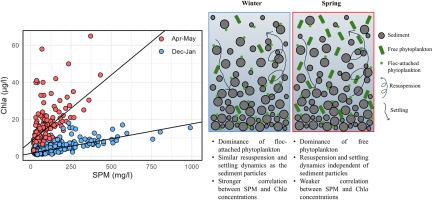Vertical dynamics of suspended particulate matter and chlorophyll-a in a well-mixed coastal turbid system
IF 2.6
3区 地球科学
Q1 MARINE & FRESHWATER BIOLOGY
引用次数: 0
Abstract
The particulate organic carbon (POC) content of suspended particulate matter (SPM) gradually increases along a horizontal gradient from high-turbidity to low-turbidity waters, reflecting a characteristic feature of SPM dynamics. Here, we investigate whether this gradual POC enrichment is also evident in the vertical in a turbid, shallow, well-mixed water column (MOW1), where variation in hydrodynamic forcing and phytoplankton production is likely to differ markedly from the cross-shore transects. Combining SPM, POC, and chlorophyll-a (Chla) data collected from surface and bottom layers at MOW1 during multiple tidal cycles between 2019 and 2022, we observe relatively higher POC and Chla content in surface waters, beginning in spring. During this season we observe a larger uncertainty in the Chla-SPM regression analysis, indicating a weaker association between the two, which contrasts winter conditions where the association is better. Monthly vertical profiles of SPM, constructed using optical backscattering sensor data, and Chla profiles from water sample data indicate that a significant fraction of phytoplankton is floc-attached and that free phytoplankton type predominates only during the growing period. Our findings suggest that, similar to the horizontal gradients in POC content of SPM, differential settling amongst various components of SPM seems to contribute to the compositional gradient within the vertical water column. Consequently, free phytoplankton cells may be able to prolong residence in the photic depths, particularly advantageous during the early stages of phytoplankton blooms when SPM concentrations remain high.

沿海混浊系统中悬浮颗粒物和叶绿素-a的垂直动态
悬浮颗粒物(SPM)颗粒有机碳(POC)含量沿水平梯度由高浊度水体向低浊度水体逐渐增加,反映了SPM动力学的特征。在这里,我们研究了在一个浑浊、浅、混合良好的水柱(MOW1)中,这种逐渐的POC富集是否在垂直方向上也很明显,在那里,水动力强迫和浮游植物生产的变化可能与跨岸样带有明显不同。结合MOW1在2019 - 2022年多个潮汐周期中收集的表层和底层SPM、POC和叶绿素a (Chla)数据,我们观察到从春季开始地表水POC和Chla含量相对较高。在这个季节,我们观察到Chla-SPM回归分析的不确定性较大,表明两者之间的关联较弱,与冬季条件相比,相关性较好。利用光学后向散射传感器数据构建的SPM月垂直剖面和来自水样数据的Chla剖面表明,浮游植物中有很大一部分是絮凝体附着的,而游离浮游植物类型仅在生长期占主导地位。我们的研究结果表明,与SPM中POC含量的水平梯度相似,SPM各组分之间的差异沉降似乎有助于垂直水柱内的成分梯度。因此,游离的浮游植物细胞可能能够延长在光深处的停留时间,在浮游植物繁殖的早期阶段,当SPM浓度保持较高时,这尤其有利。
本文章由计算机程序翻译,如有差异,请以英文原文为准。
求助全文
约1分钟内获得全文
求助全文
来源期刊
CiteScore
5.60
自引率
7.10%
发文量
374
审稿时长
9 months
期刊介绍:
Estuarine, Coastal and Shelf Science is an international multidisciplinary journal devoted to the analysis of saline water phenomena ranging from the outer edge of the continental shelf to the upper limits of the tidal zone. The journal provides a unique forum, unifying the multidisciplinary approaches to the study of the oceanography of estuaries, coastal zones, and continental shelf seas. It features original research papers, review papers and short communications treating such disciplines as zoology, botany, geology, sedimentology, physical oceanography.

 求助内容:
求助内容: 应助结果提醒方式:
应助结果提醒方式:


